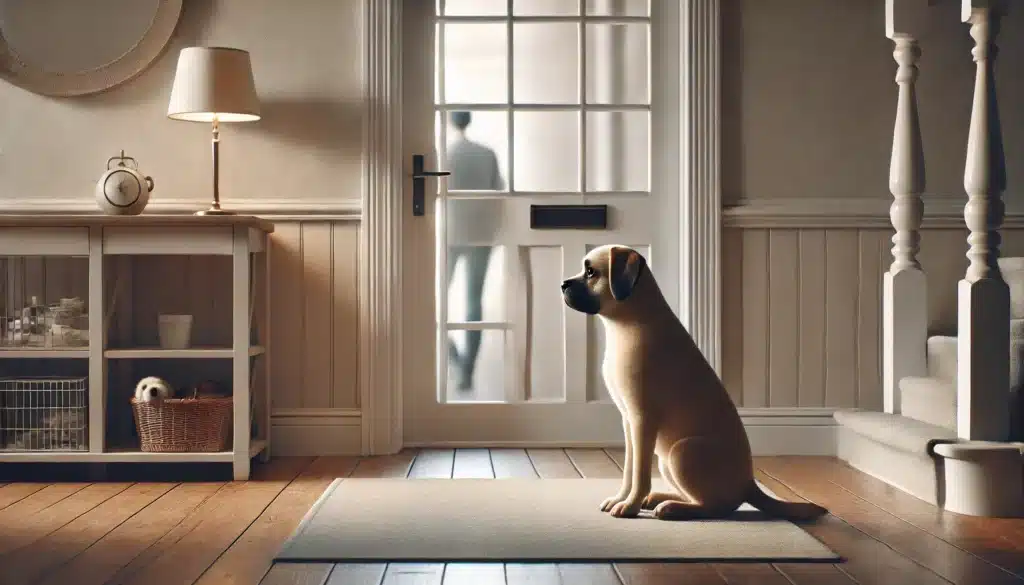If your dog whines, barks, destroys furniture, or has accidents when you leave the house — you might be dealing with separation anxiety. It’s one of the most common (and misunderstood) behavioral issues in dogs, and it can affect both your dog’s well-being and your daily life.
In this guide, you’ll learn what separation anxiety really is, how to recognize the signs, and — most importantly — how to help your dog feel calm, safe, and confident when they’re home alone.
What Is Separation Anxiety in Dogs?
Separation anxiety is a panic response that occurs when a dog is separated from their owner or left alone. It’s not just boredom — it’s genuine distress.
Think of it like a panic attack. The dog feels overwhelmed, afraid, and doesn’t know when or if you’re coming back.
Common Signs of Separation Anxiety
🚨 While You’re Gone:
- Non-stop barking, whining, or howling
- Chewing or destroying doors, windows, furniture
- Scratching at doors or digging at exits
- Indoor urination or defecation (even if house-trained)
- Pacing or restlessness
- Escaping (or trying to escape) from crates or rooms
😢 When You’re Getting Ready to Leave:
- Shadowing you around the house
- Panting or shaking as you grab keys or put on shoes
- Hiding or becoming clingy
- Blocking the door or trying to stop you from leaving
🐾 When You Return:
- Over-the-top greetings
- Excessive excitement or barking
- Clinginess or refusal to leave your side
If your dog shows one or more of these behaviors consistently when left alone, separation anxiety is a likely cause.
What Causes Separation Anxiety?
There’s no single cause, but common triggers include:
- Sudden schedule changes (e.g. working from home, then going back to the office)
- Rehoming or adoption from a shelter
- Loss of a family member or another pet
- Traumatic experiences when left alone (e.g. loud storm, accident)
- Lack of early independence training as a puppy
Some breeds are more prone to anxiety — especially those bred to be close to humans (Labradors, German Shepherds, Border Collies, etc.).
How to Help a Dog with Separation Anxiety
1. Start with a Vet Visit
Before anything else, rule out medical causes for the behavior. Urinary tract infections, gastrointestinal issues, or pain can lead to house soiling or restlessness.
2. Avoid Punishment
Never scold your dog for anxiety-related behavior. They’re not being “bad” — they’re scared. Punishment will make the anxiety worse and destroy trust.
3. Desensitize Departure Cues
Dogs pick up on small signs that you’re leaving (grabbing keys, putting on shoes). To reduce anxiety:
- Pick up your keys and sit back down
- Put on your coat and watch TV
- Practice these cues until they stop reacting
This helps them realize these actions don’t always mean you’re leaving.
4. Practice Gradual Alone Time
Build up tolerance slowly with short absences:
- Step outside for 30 seconds
- Return calmly (no fuss)
- Repeat, increasing time by 30 seconds to a minute each time
- Mix in unpredictability — don’t always leave for the same length
Go slowly. If your dog panics, shorten the time and rebuild.
5. Create a Calm Leaving Routine
Keep departures low-key:
- No hugs, kisses, or sad goodbyes
- Act casual and confident
- Ignore clingy behavior before you leave
Same for returning — wait a few minutes before giving affection.
6. Use Enrichment to Occupy Their Mind
Provide mental stimulation during alone time:
- Food puzzles or slow feeders
- Lick mats with peanut butter or yogurt (xylitol-free)
- Frozen Kongs stuffed with food
- Chew-safe bones or toys
- Calming music or white noise
This redirects their focus and helps build positive associations.
7. Create a Safe, Comfortable Space
Some dogs feel safer in a designated “den” area:
- A cozy crate (if crate-trained)
- A gated room with bedding and toys
- Calming sprays (like Adaptil) or calming dog beds
Make sure they always have access to fresh water and ventilation.
8. Build Confidence Through Training
Work on obedience and independence-building exercises:
- “Place” or “Stay” commands with increasing distance
- Reward calm behavior when they’re away from you
- Ignore demand barking or excessive attention-seeking
- Use positive reinforcement at all times
Confident dogs are less likely to panic when alone.
9. Try Natural Calming Aids
These may help in mild to moderate cases:
- CBD treats or oil (vet-approved only)
- Calming supplements (L-theanine, chamomile, valerian root)
- Calming collars or diffusers
- ThunderShirts or anxiety wraps
Always consult your vet before starting supplements.
10. Consider Professional Help
If your dog’s anxiety is severe or not improving:
- Hire a certified dog trainer or behaviorist
- Ask your vet about anti-anxiety medication
- Consider daycare or a dog walker to avoid long periods of isolation
Professional guidance can be a game-changer for severe cases.
Final Thoughts: Patience, Not Pressure
Separation anxiety doesn’t go away overnight — but with patience, structure, and a loving approach, you can help your dog feel secure and confident even when you’re not home.
The most important thing to remember? Your dog isn’t trying to upset you — they’re just trying to cope. And with your support, they can learn that being alone isn’t scary after all.







